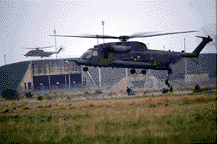MH-53J Pave Low III

Mission
The MH-53J's mission is to perform low-level, long-range, undetected penetration into denied areas, day or night, in adverse weather, for infiltration, exfiltration and resupply of special operations forces.
Features
The MH-53J Pave Low III heavy-lift helicopter is the largest and most powerful helicopter in the Air Force inventory, and the most technologically advanced helicopter in the world. Its terrain-following, terrain-avoidance radar and forward-looking infrared sensor, along with a projected map display, enable the crew to follow terrain contours and avoid obstacles, making low-level penetration possible.
The helicopter is equipped with armor plating, and a combination of three 7.62mm miniguns or .50 caliber machine guns. It can transport 38 troops or 14 litters and has an external cargo hook with a 20,000-pound (9,000-kilogram) capacity.
The MH-53J has twin turbo-shaft engines; self-lubricating, all-metal main and tail rotors; and a large horizontal stabilizer on the tail rotor pylon's right side.
Background
The MH-53J Pave Low is a modified version of the HH-53 Super Jolly Green Giant helicopter used extensively during the Vietnam War for special operations and rescue of combat personnel. During past space programs, the HH-53 was on duty at the launch site as the primary astronaut recovery vehicle. Under the Air Force's Pave Low IIIE program, nine MH-53H's and 32 HH-53s were modified for night and adverse weather operations and designated MH-53J's. Their modifications included forward-looking infrared, inertial global positioning system, Doppler navigation systems, a terrain-following and terrain-avoidance radar, an on-board computer and integrated avionics to enable precise navigation to and from target areas.
MH-53J's were used in a variety of missions during Desert Storm. Pave Lows were among the first aircraft into Iraq when they led Army AH-64 Apaches to destroy Iraqi early warning radars and opened a hole in enemy air defenses for the opening air armada. In addition to infiltration, exfiltration and resupply of special forces teams throughout Iraq and Kuwait, Pave Lows provided search and rescue coverage for coalition air forces in Iraq, Saudi Arabia, Kuwait, Turkey and the Persian Gulf.
An MH-53J made the first successful combat recovery of a downed pilot in Desert Storm. Following the war, MH-53J's were deployed to Northern Iraq to support Operation Provide Comfort, assisting displaced Kurds. Pave Lows were also used extensively during Operation Just Cause in Panama.
General Characteristics
Primary
Function: Special operations forces long-range delivery and resupply
under adverse weather conditions
Builder:
Sikorsky Aircraft Corp.
Power Plant:
Two General Electric T64-GE-100 engines
Thrust:
4,330 shaft horsepower per engine
Length:
92 feet (28 meters)
Height: 25
feet (7.6 meters)
Rotary
Diameter: 72 feet (21.9 meters)
Speed:
165 mph (264 kph)
Ceiling: 16,000
feet (4,849 meters)
Maximum Takeoff
Weight: 46,000 pounds (18,900 kilograms), emergency war plan allows
for 50,000 pounds
Range:
630 statute miles (550 nautical miles); unlimited with air refueling
Armament: Any
combination of three 7.62 miniguns and .50 caliber machine guns
Unit cost: $25
million (1993 dollars)
Crew: Two
officers (pilots); four enlisted (two flight engineers, two aerial gunners)
Date
Deployed:
1981
Inventory:
Active force, 41; ANG, 0; Reserve, 0
